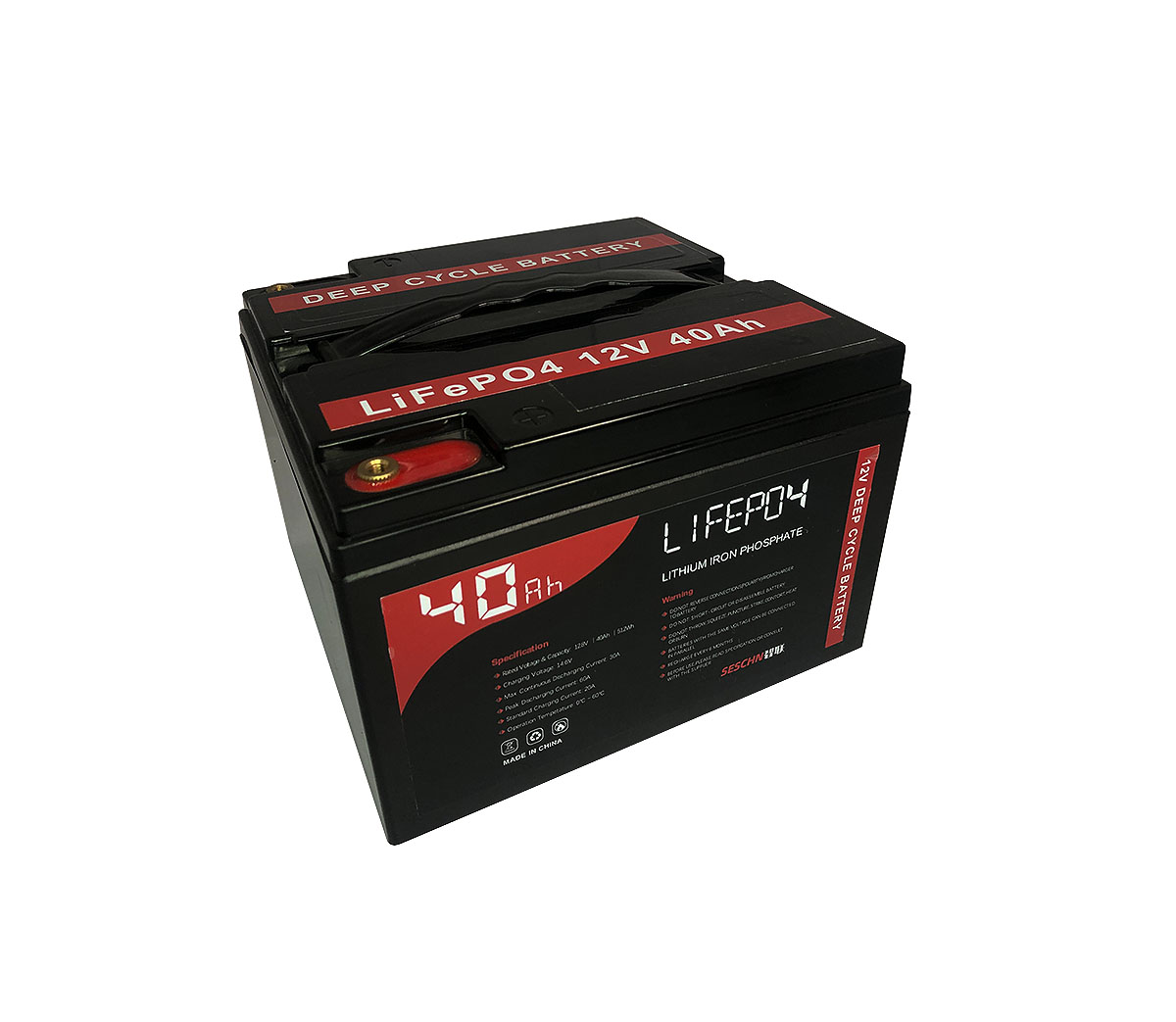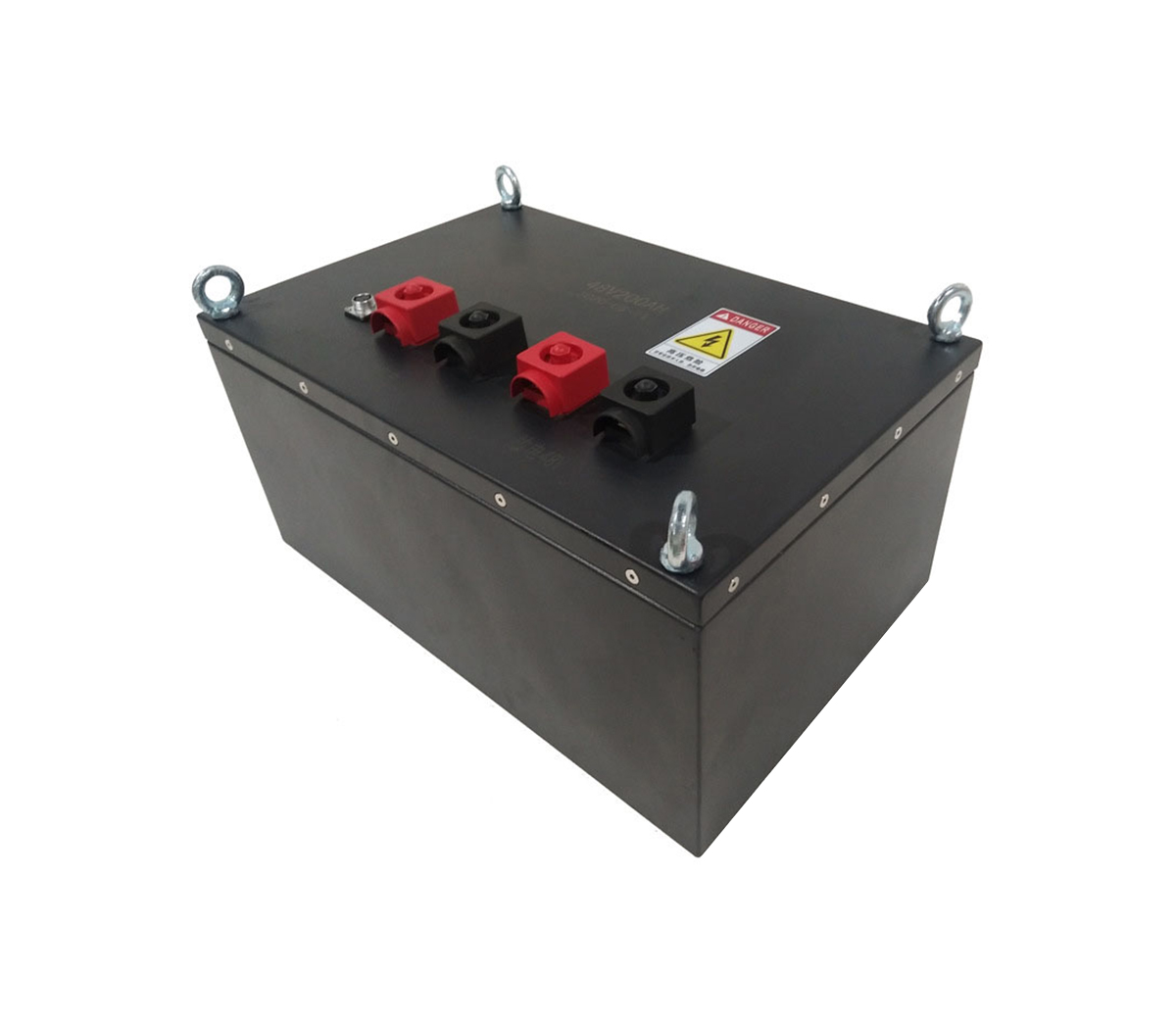Analysis Report (1): Cost and Value of Hybrid Energy Storage Projects in
the United States
The rapid deployment of wind and solar power projects is one of the most
important power system trends of the 2010s, and survey data suggest that a
tipping point in the 2020s may be the rapid deployment of "hybrid" deployment
projects.
SES Power has nearly 20 years of experience in the customized lithium
battery industry. We use EVE, CATL, BYD square aluminum lithium iron phosphate
batteries to develop and produce 12V100Ah, 24V100Ah, 36V100Ah, 48V100Ah, 60V100,
and 3KW home energy storage. , 5KW system, rack-mounted energy storage system
and other products. Almost all of these products are standardized and
modularized. They integrate RS485, CAN and other communication protocols to
support remote monitoring and operation. At the same time, AI intelligent
analysis and cloud storage are added to the new generation of systems, which can
ensure system compatibility, high speed and reliability. In the energy storage
industry, the United States is one of the most promising places in the world,
and we have compiled the following information about hybrid energy storage
projects in the United States for you.
Hybrid deployments typically co-locate solar power projects or wind power
projects (or other energy sources) with battery storage systems. Just as falling
costs have driven rapid growth in solar and wind projects over the past decade,
falling battery prices and the growing need to integrate renewable energy
generation are driving plans to deploy hybrid projects. While hybrid deployments
can help alleviate the challenge of balancing intermittent supply from
renewables, their relative novelty means that research is needed to foster
integration and innovation.
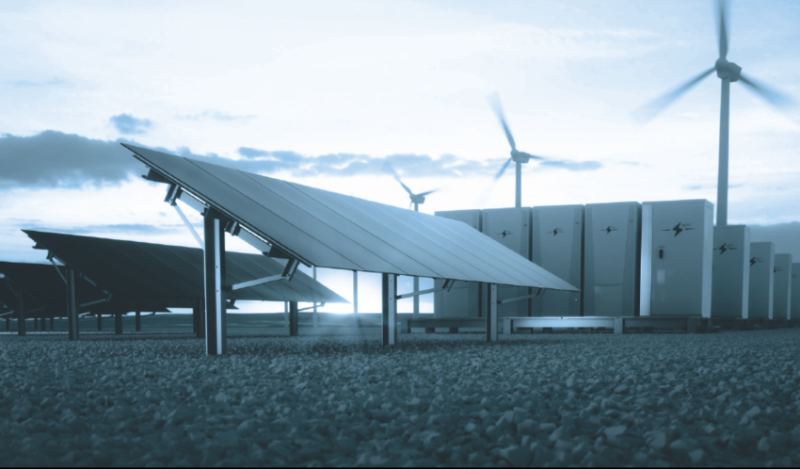
Combining energy storage and conversion technologies and the
characteristics of multiple renewable energy sources creates complex issues for
grid operations and costs. And project developers, system operators, planners
and regulators need to estimate the cost, value and system impact of hybrid
projects in order to benefit from better data, methodologies and tools.
Opportunities to deploy hybrid deployments are increasing as the power system
moves towards more renewable power, but their impact and optimal application
have yet to be determined.
The Lawrence Berkeley Laboratory (Berkeley Lab) recently released a
research report titled "Top Ten Findings from the Renewable Energy Research
Project". The report analyzes where and why hybrid deployments are built, models
optimal hybrid design choices, and assesses hybrid deployments' contribution to
resource adequacy and short-term supply reliability.
How to define a hybrid hybrid deployment project?
• Combination of power generation facilities and battery storage
systems.
• Operates as one or two independent generating units.
• Co-located.
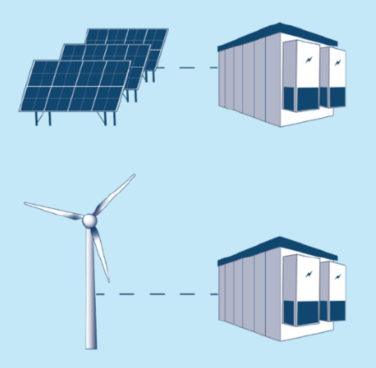
Top 10 findings of the Renewable Energy Research Project:
(1) Growth
Interest in hybrid deployment projects is strong and growing among
renewable energy developers.
(2) Price VS Value
Solar + energy storage projects have low power purchase prices but high
value in some regions.
(3) Market driving factors
Solar-plus-storage projects are driven by tax credits and other
incentives.
(4) Configuration selection
Market prices have incentivized solar power facilities to deploy short-term
battery storage systems.
(5) Capacity value
The capacity contribution of a hybrid deployment project is less than the
sum of its parts.
(6) Ancillary services
The ancillary services market is a valuable but short-lived option for
hybrid deployment projects.
(7) Market participation
Hybrid deployment projects can participate more flexibly in the electricity
market.
(8) Operation
The power system value of hybrid deployment project systems depends on how
they operate.
(9) Distributed hybrid deployment project
The growth of solar-plus-storage projects at customer sites presents new
opportunities.
(10) Future Research
How will the future develop? A priority area of research for hybrid
deployment projects.
a. to grow
(1) Strong and growing interest from renewable energy developers in hybrid
deployment projects
Falling battery prices and demand for renewable energy generation have
driven interest in hybrid deployment projects. Current developer interest is
focused on deploying solar power generation facilities with battery energy
storage systems, but energy storage systems can be deployed with a variety of
renewable energy generation facilities.
(2) By the end of 2021, the number of solar + energy storage projects or
wind power + energy storage projects already connected to the grid in the United
States has exceeded 8GW
Solar+storage projects dominate the total installed capacity of hybrid
deployments with more than 5.9GW of installed capacity, while wind+storage
projects are only 2GW and solar+wind+storage projects are only 750MW. And this
market has already started to grow exponentially, with a 133% increase in the
cumulative installed capacity of operational hybrid deployment projects in 2021
compared to the cumulative installed capacity deployed at the end of 2020.
Although there are many hybrid deployment projects of fossil energy + energy
storage, the total installed capacity is relatively small.
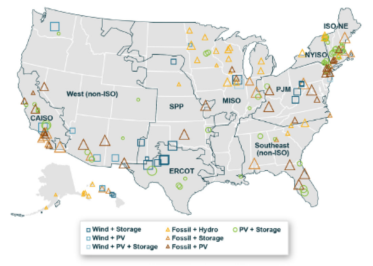
(Location of existing hybrid deployment projects in the U.S. by 2020)
(3) Plans for planned deployment indicate growing interest in hybrid
deployment projects of renewable energy and energy storage systems
Data from energy projects under development in interconnected cohorts of
seven wholesale markets and 35 utilities in the U.S. suggest that renewable
energy developers have considerable commercial interest in hybrid deployment
projects.
By the end of 2021, the installed capacity of solar power generation
facilities planned to be deployed in the United States exceeds 675GW, of which
286GW (about 42%) are proposed as hybrid deployment projects, the most common
deployment of solar power generation facilities and energy storage systems.
There are also plans to deploy 247GW of wind power facilities, of which 19GW
(about 8%) are proposed as hybrid deployment projects, which are also usually
deployed with wind power facilities and energy storage systems.
While many of these proposed projects will ultimately fail to achieve
commercial operations, strong interest in deploying hybrid deployments bodes
well for strong capacity growth. This is especially true in the California
Independent System Operator (CAISO) service area, where 95 percent of solar and
42 percent of wind facilities are proposed for hybrid deployments.

Figure 2. The installed capacity of hybrid deployment projects planned for
deployment in the United States in 2021
B. Price vs Value
(1) The power purchase price of solar + energy storage projects in some
areas is low but the value is high
While the number of hybrid deployments currently operating in the U.S. is
still small (but growing), it is possible to gain insight into the configuration
and pricing of upcoming hybrid deployments by looking at power purchase
agreements (PPAs), which are often the project was implemented several years
before it was put into operation.
(2) The electricity purchase price of solar + energy storage projects will
gradually decrease
In the price sample, the price (USD/MWh) of a hybrid solar+storage
deployment project (shown in the figure below as an open circle reflecting the
installed capacity ratio of battery storage systems to solar power generation
facilities) is close to the price of independently deployed solar power
generation facilities (smaller filled circle).
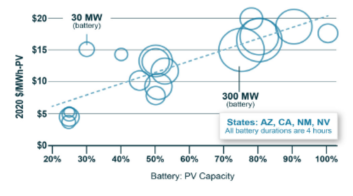
As a result, solar-plus-storage projects will become more common over time.
And in Hawaii (orange), almost every utility-scale solar facility that signed a
power purchase agreement (PPA) after 2017 was equipped with battery storage, and
the balance appears to be in the other four states shown (blue) changed. These
power purchase agreement (PPA) levelized prices reflect the US federal
Investment Tax Credit (ITC) incentives.
(3) The power purchase agreement (PPA) premium of the hybrid deployment
project reflects the scale of its battery storage system
A subsample of 17 power purchase agreements (PPAs) separates the price of
each component of a solar-plus-storage project, enabling an accurate calculation
of how much power purchase agreement (PPA) prices for storage systems have
increased.
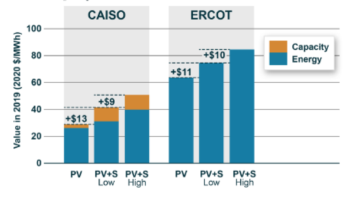
The ratio of battery to solar capacity increases linearly (above), which is
one of several reasons why hybrid deployments in Hawaii (all batteries are
relatively large) are more expensive than other states in the graph one.
(4) Hybrid deployment projects are almost always net worth
Berkeley Lab modeled the value of California Independent System Operators
(CAISO) and Electric Reliability Commission of Texas (ERCOT) independently
deployed solar power facilities supporting battery energy storage systems with
an installed capacity of 50% for solar power facilities. Half of the installed
capacity for a duration of 4 hours (as shown in the picture below).
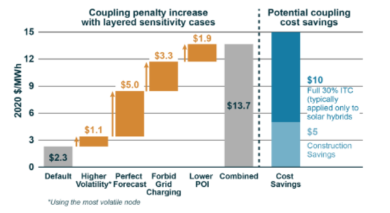
This configuration should increase power purchase agreement (PPA) prices by
$8-$13/MWh. Of course, the value of a hybrid deployment project will vary over
the life of a power purchase agreement (PPA), but at least in recent years, and
with the help of the federal Investment Tax Credit (ITC), the added value
appears to be Justify the price premium.
C. Market Drivers
(1) Solar+storage projects are driven by tax credits and other
incentives
Hybrid deployments and co-located renewable energy facilities and battery
storage systems can benefit from tax credits, construction cost savings, and
more flexible generation facility scheduling, but are subject to site selection
constraints.
(2) Access to investment tax credits is a major reason for promoting hybrid
deployments
Co-locating solar and battery storage is required to make battery storage
eligible for federal investment tax credits, save on shared facility and
interconnection and permitting costs, reduce solar curtailment, and facilitate
energy transfer. In addition, renewable energy generation facilities deployed in
conjunction with battery energy storage systems have greater dispatch
flexibility, making them more attractive for grid operations.
(3) The location of deployment may not be where the energy storage system
provides the greatest benefit to the grid
Large-scale wind power projects and solar power projects are usually
deployed in places with abundant power generation resources, vast land and can
be connected to the grid. And battery storage systems can be deployed almost
anywhere, such as high-value locations that can provide additional value to the
local grid, such as alleviating grid congestion and mitigating price volatility.
The study found that, depending on the region and year, the market value of a
separate deployment of renewable energy generation and battery storage is $2 to
$9/MWh higher than a hybrid deployment. Across seven wholesale markets in the
US, this “coupling loss” averages $2/MWh (as shown in the chart below).
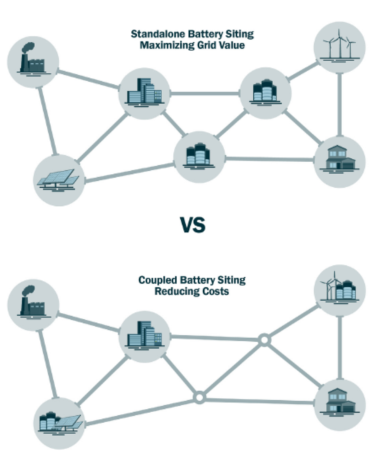
(4) The higher costs of deploying projects independently are largely offset
by the cost savings of hybrid deployments
A rough cost savings of $15/MWh was calculated in the study, with $10 from
the 30% investment tax credit (ITC) earned and $5 from construction cost
savings—both above the default coupling loss. However, if the battery storage
system is only charged from co-located renewable energy generation facilities,
if the interconnection capacity is limited by the size of the renewable energy
generation facilities, and the storage system dispatch can operate with perfect
predictability, then the coupling Losses could increase to $14/MWh.
Uncertainty about coupling losses and cost savings for hybrid deployment
projects shows that development models for both independent and hybrid
deployment projects are feasible.
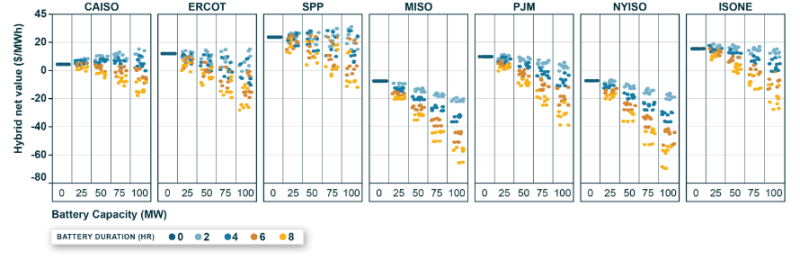
(Site selection for independent deployment of battery energy storage
systems vs. site selection for co-location deployment of battery energy storage
systems)
D. Configuration selection
(1) Market price encourages solar power generation facilities to deploy
short-term battery energy storage systems
We found significant differences in the final figures by configuration and
region, with solar generation penetration being a major factor.
(2) The duration and energy storage capacity of the battery energy storage
system have the greatest impact on the net value of the hybrid deployment
project
In the most attractive hybrid deployment project configuration to receive
the Federal Investment Tax Credit (ITC), the duration of the battery energy
storage system is often 2 to 4 hours, and the installed capacity of the
supporting battery energy storage system is a solar power installation or 25% or
100% of the installed capacity of the wind power facility, depending on the
region (shown below).
Setting grid interconnection capacity to allow both renewable generation
and energy storage to discharge simultaneously would yield a higher net hybrid
value than limiting the interconnection size to only solar or wind
installations.
(3) Among the areas served by CAISO, ERCOT and SPP, the net value of solar
+ energy storage projects with short duration is the highest
The duration of grid-connected projects and proposed deployments is
typically 1 to 4 hours. Among all battery storage systems, the relative value of
hybrid deployments is highest among the California Independent System Operator
(CAISO), Electric Reliability Commission of Texas (ERCOT), and Southwest Power
Associates (SPP) service areas, which have a large number of proposed Deployed
solar + energy storage projects. The study also found that the net worth of
solar-plus-storage projects is more attractive than wind-plus-storage projects
when the federal Investment Tax Credit (ITC) is included.
(4) The penetration rate of solar energy in the region promotes the value
of solar + energy storage projects
High solar penetration shifts the time of grid price peaks from summer
afternoons to evenings, enabling solar power utility projects to gain greater
value. California Independent System Operators (CAISOs) have had the greatest
impact so far, with solar penetration reaching 21% in 2020.
However, as energy storage systems improve the ability to transfer energy,
the deployment of solar power facilities projects that cut power generation to
change the timing of power generation has become redundant. In contrast,
configurations that maximize solar power generation (including through
single-axis tracking systems and scaling solar power facilities) can provide
greater net benefit when combined with energy storage.


















